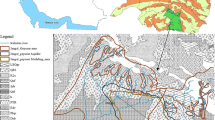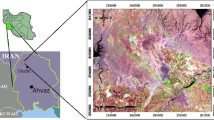Abstract
Water scarcity in urban areas is a common problem in many cities of India, and Visakhapatnam, a fast growing industrial city on the east coast of India, is no exception. Increasing urban population, industrial expansion and shrinking surface-water sources have widened the gap between the demand and supply, resulting in groundwater depletion and saline water intrusion along the coastal region. MODFLOW is a widely used numerical groundwater flow model but requires realistic estimation of field inputs in order to contribute effectively to recommendations for proper management actions. The present study focuses on computing the spatial and temporal variations of model inputs such as pumping and recharge rates using the field data collected from various organizations. The developed PMWIN MODFLOW model provides insight into the present and future trends in the variation of groundwater levels. Observation wells data are used in the model calibration to fix the aquifer parameters through the parameter estimation algorithm PEST. Models are performed for four projected scenarios with different rates of pumping and recharge values. Results indicate the importance of improving the recharge capability of potential areas, to sustain the aquifer’s capacity to cope with stresses on groundwater resources. The model results are useful to fix optimum pumping limits in the study area for sustainable groundwater management and will help to prevent disastrous impacts on groundwater potential in the future.
Résumé
La pénurie d’eau dans les zones urbaines est un problème courant dans de nombreuses villes en Inde, et Visakhapatnam, une ville industrielle à croissance rapide sur la côte orientale de l’Inde, ne fait pas exception. L’accroissement de la population urbaine, le développement industriel et la diminution des ressources en eaux de surface ont eu pour conséquence l’agrandissement de l’écart entre la demande et l’offre, entraînant l’épuisement des eaux souterraines et l’intrusion d’eau salée le long de la région côtière. MODFLOW est un modèle numérique d’écoulement des eaux souterraines largement utilisé, mais qui exige une estimation réaliste des termes du bilan hydrologique issus du terrain afin que les résultats puissent permettre de contribuer de manière efficaces en formulant des recommandations en termes d’actions appropriées de gestion des ressources en eau. La présente étude porte sur le calcul des variations spatiales et temporelles des termes d’entrée du modèle tels que les débits de pompage et taux de recharge en utilisant les données de terrain recueillies auprès de diverses organisations. Le modèle MODFLOW PMWIN développé donne un aperçu des tendances actuelles et futures de la variation des niveaux d’eau souterraine. Les données piézométriques sont utilisées dans la calibration du modèle pour déterminer les paramètres de l’aquifère à l’aide de l’algorithme d’estimation PEST. Les modèles sont exécutés pour quatre scénarios projetés avec différents débits de pompage et taux de recharge. Les résultats indiquent l’importance d’améliorer la capacité de recharge des zones potentielles, afin de maintenir la capacité de l’aquifère à faire face aux tensions sur les ressources en eaux souterraines. Les résultats du modèle sont utiles pour fixer les limites optimales de pompage dans la zone d’étude pour la gestion durable des eaux souterraines et contribueront à éviter des impacts désastreux sur les ressources en eau souterraine à l’avenir.
Resumen
La escasez de agua en las zonas urbanas es un problema común en muchas ciudades de la India, y Visakhapatnam, una ciudad industrial de rápido crecimiento en la costa este de la India, no es una excepción. El aumento de la población urbana, la expansión industrial y la reducción de las fuentes de agua superficial han ampliado la brecha entre la demanda y la oferta, lo que ha provocado el agotamiento del agua subterránea y la intrusión de agua salina a lo largo de la región costera. MODFLOW es un modelo numérico de flujo de agua subterránea ampliamente utilizado, pero requiere una estimación realista de las entradas de campo para contribuir eficazmente a las recomendaciones de acciones de gestión adecuadas. El presente estudio se centra en el cálculo de las variaciones espaciales y temporales de los insumos del modelo, tales como los caudales de bombeo y la recarga utilizando los datos de campo recopilados de diversas organizaciones. El modelo PMWIN MODFLOW desarrollado proporciona una idea de las tendencias presentes y futuras en la variación de los niveles de agua subterránea. Los datos de los pozos de observación se utilizan en la calibración del modelo para fijar los parámetros del acuífero a través del algoritmo de estimación de parámetros PEST. Los modelos se realizan para cuatro escenarios proyectados con diferentes valores de caudales de bombeo y recarga. Los resultados indican la importancia de mejorar la capacidad de recarga de las áreas potenciales, para mantener la capacidad del acuífero para hacer frente a los estreses en los recursos de agua subterránea. Los resultados del modelo son útiles para fijar los límites óptimos de bombeo en el área de estudio para la gestión sostenible del agua subterránea y ayudarán a evitar impactos desastrosos en el potencial del agua subterránea en el futuro.
摘要
在印度很多城市,城区缺水是一个普遍的问题,印度东海岸工业快速发展的城市Visakhapatnam也不例外。日益增长的人口、工业扩张、地表水资源的缩减加大了供需缺口,导致地下水枯竭及沿海岸地区咸水入侵。MODFLOW是一款广泛应用的数值地下水水流模型,但需要野外输入项的切合实际的估算值以便有效地为恰当的管理行动提供建议。本研究聚焦于采用通过从各种组织采集的野外数据来计算模型输入项诸如抽水量和补给量的时空变化。开发的PMWIN MODFLOW模型增进了人们对目前和将来地下水位的变化趋势的认识。观测井数据用于模型校正,通过参数估算算法PEST设定含水层参数。采用不同抽水量和不同补给量的四种不同的方案来运行模型。结果显示了提高潜在区域的补给能力、维持含水层应对地下水资源压力的能力的重要性。模型结果对于研究区可持续的地下水管理设定最优抽水限度非常有用,并且有助于预防灾害对未来地下水潜力的影响。
Resumo
Escassez hídrica em áreas urbanas é um problema comum em muitas cidades da Índia, e Visakhapatnam, uma cidade industrial de rápido crescimento no leste da costa da Índia, não é exceção. O aumento populacional urbano, a expansão industrial e a diminuição dos recursos hídricos superficiais têm ampliado a lacuna entre a demanda e o suprimento, resultando na diminuição das águas subterrâneas e na intrusão salina ao longo da região costeira. O MODFLOW é um modelo numérico de escoamento de águas subterrâneas amplamente usado, porém requer estimativas realísticas de dados de entrada de campo para contribuir efetivamente às recomendações para ações apropriadas de gerenciamento. O presente estudo enfatiza o cálculo das variações espacial e temporal dos dados de entrada do modelo, tais como bombeamento e taxas de recarga usando dados de campo coletados em várias organizações. O modelo PMWIN MODFLOW desenvolvido fornece informações sobre as tendências presente e futura na variação dos níveis de águas subterrâneas. Dados de poços de observação são usados na calibração do modelo para corrigir os parâmetros do aquífero, obtidos por meio algoritmo de estimação de parâmetro PEST. Os modelos são realizados para quatro cenários projetados com diferentes taxas de bombeamento e valores de recarga. Os resultados indicam a importância de melhorar a capacidade de recarga de áreas potenciais, a fim de segurar a capacidade do aquífero para lidar com o estresse sobre os recursos hídricos subterrâneos. Os resultados do modelo são úteis para corrigir limites ideais de bombeamento na área de estudo para o gerenciamento sustentável das águas subterrâneas, e irão ajudar na prevenção de impactos desastrosos sobre o potencial das águas subterrâneas no futuro.
























Similar content being viewed by others
References
Abhishek V, Jitendra T, Purnachandra R, Dheeraj K (2016) Draft detailed project report on water and energy audit study for Visakhapatnam. Report submitted by TATA Consulting Eng. to Public Health and Municipal Eng. Dept., Visakhapatnam, India
Alam F, Umar R (2013) Groundwater flow modelling of Hindon-Yamuna interfluve region, Western Utter Pradesh. J Geol Soc India 82:80–90
Anderson MP, Woessner WW (2002) Applied groundwater modeling-simulation of flow and advective transport. Academic, New York
Bhaskara Rao G (2012) Ground water brochure for Visakhapatnam district, Andhra Pradesh. Report by CGWB, Ministry of Water Resources, Government of India, New Delhi
Ground Water Estimation Committee (2015) Report of the Ground Water Resource Estimation Committee, Ministry of Water Resources, River Development and Ganga Rejuvenation. Government of India, New Delhi
Hargreaves GH, Richard GA (2003) History and evaluation of Hargreaves evapotranspiration equation. J Irrig Drain Eng 129(1):53–63
Heyddy CP, Laurence RB (2007) A regional-scale groundwater flow model for the Leon-Chinandega aquifer, Nicaragua. Hydrogeol J 15:1457–1472
Houcyne EII, Florimond De S (2006) Modelling groundwater flow of the Trifa aquifer, Morocco. Hydrogeol J 14:1265–1276
Izady A, Abdalla O, Joodavi A, Chen M (2017) Groundwater modeling and sustainability of a transboundary hardrock-alluvium aquifer in North Oman Mountains. Water 9(3):161. https://doi.org/10.3390/w9030161
Kanak M, Chaitanya P, Sanjay P (2017) Inverse modeling of aquifer parameters in basaltic rock with the help of pumping test method using MODLFOW software. J Geosci Front 8:1385–1395
Mahammood V (2003) Some studies on assessment and development of groundwater resources for the city of Visakhapatnam, State of Andhra Pradesh, India, using Remote Sensing & GIS Approach. PhD Thesis, Andhra University College of Engineering, Visakhapatnam, India
Maheswaran R, Khosa R, Gosain KA, Lahari S, Sinha SK, Chahar BR, Dhanya CT (2016) Regional scale groundwater modelling study for Ganga River Basin. J Hydrol 541:727–741
McDonald MG, Harbaugh AW (1988) A modular three-dimensional finite difference groundwater flow model. US Geol Surv Open File 83-0875
Nepal CM, Singh VP, Sankaran S (2011) Groundwater flow model for a Tannery Belt in southern India. J Water Resour Prot 3:85–97
Paul MJ (2006) Impact of land use pattern on distributed groundwater recharge and discharge. Chin Geogr Sci 16(3):229–235
Ramakrishna C, Mallikarjuna Rao D, Subba Rao K, Srinivas N (2009) Studies on groundwater quality in slums of Visakhapatnam, Andhra Pradesh. Asian J Chem 21(6):4246–4250
Ramakrishnan D, Bandyopadhyay A, Kusuma KN (2009) SCN-CN and GIS based approach for identifying potential water harvesting sites in the Kali watershed, Mahi River basin, India. J Earth Syst Sci 118(4):355–360
Rastogi AK (2007) Numerical groundwater hydrology, 1st edn. Penram, Mumbai, India, pp 145–182
Rejani R, Jha MK, Panda SN, Mull R (2003) Hydrologic and hydrogeologic analyses in a coastal groundwater basin, Orissa, India. Appl Eng Agric 19(2):177–186
Satyanarayana P, Appala Raju N, Harikrishna K, Viswanath K (2013) Urban groundwater quality assessment: a case study of greater Visakhapatnam municipal corporation area (GVMC), Andhra Pradesh, India. Int J Eng Sci Invent 2(5):20–31
Shiquin W, Jingli S, Xianfang S, Yongbo ZH, Xiaoyuan Z (2008) Application of MODFLOW and geographic information system to groundwater flow simulation in North China plain, China. Environ Geol 55:1449–1462
Srinivas Rao G, Nageswara Rao G (2009) Study of groundwater quality in greater Visakhapatnam City, Andhra Pradesh (India). J Environ Sci Eng 52(2):137–146
Srisailanath A, Rao PN (1999) Hydrogeology and ground water quality in Visakhapatnam urban area and environs. Report by CGWB, Ministry of Water Resources, Government of India, New Delhi
Surinaidu L, Gurunadha Rao VVS, Nandan MJ, Khokher CS, Yugraj V, Choudhary SK (2015) Application of MODFLOW for groundwater seepage problems in the subsurface tunnels. J Geophys Union 19(4):422–432
Surinaidu L, Gurunadha Rao VVS, Srinivasa Rao N, Srinu S (2014) Hydrogeological and groundwater modeling studies to estimate the groundwater inflows into the coal mines at different mine development stages using MODFLOW, Andhra Pradesh, India. Water Resour Ind 7–8:49–65.
USDA-SCS (1972) National engineering handbook, hydrology, section 4, chapters 4–10. USDA-SCS, Washington, DC
Wen-Hsing C, Wolfgang K (1998) Processing modflow: a simulation system for modeling groundwater flow and pollution. http://docplayer.net/14116998-Processing-modflow-a-simulation-system-for-modeling-groundwater-flow-and-pollution-wen-hsing-chiang-and-wolfgang-kinzelbach.html. Accessed August 2018
Yongxin X, Hans EB (2003) Groundwater recharge estimation in Southern Africa. UNESCO IHP Series no. 64, UNESCO, Paris
Zhonggen W, Yuzhou L, Xinjun Z, Rui W, Wei L, Minghua Z (2013) Watershed modeling of surface water-groundwater interaction under projected climate change and water management in the Haihe River Basin, China. Br J Environ Clim Chang 3(3):421–443
IMSD (1995) Integrated Mission for Sustainable Development technical guidelines. National Remote Sensing Agency, Deparment of Space, Goverment of India, Hyderabad.
Acknowledgements
The authors wish to thank the directors and heads of the various state and central government institutions like GVMC, CPO, IMD and CGWB Visakhapatnam for their support in providing the necessary data for carrying out this work. We would like to thank Mr. A.V.S.S. Anand, CGWB, National Ground Water Training and Research Institute, Raipur, for technical assistance during this work. We are grateful to Dr. Martin Appold (editor), Dr. Mingjie Chen (associate editor) and an anonymous reviewer for their insightful comments, which helped to improve the quality of this paper significantly.
Author information
Authors and Affiliations
Corresponding author
Rights and permissions
About this article
Cite this article
Suryanarayana, C., Mahammood, V. Groundwater-level assessment and prediction using realistic pumping and recharge rates for semi-arid coastal regions: a case study of Visakhapatnam city, India. Hydrogeol J 27, 249–272 (2019). https://doi.org/10.1007/s10040-018-1851-x
Received:
Accepted:
Published:
Issue Date:
DOI: https://doi.org/10.1007/s10040-018-1851-x




